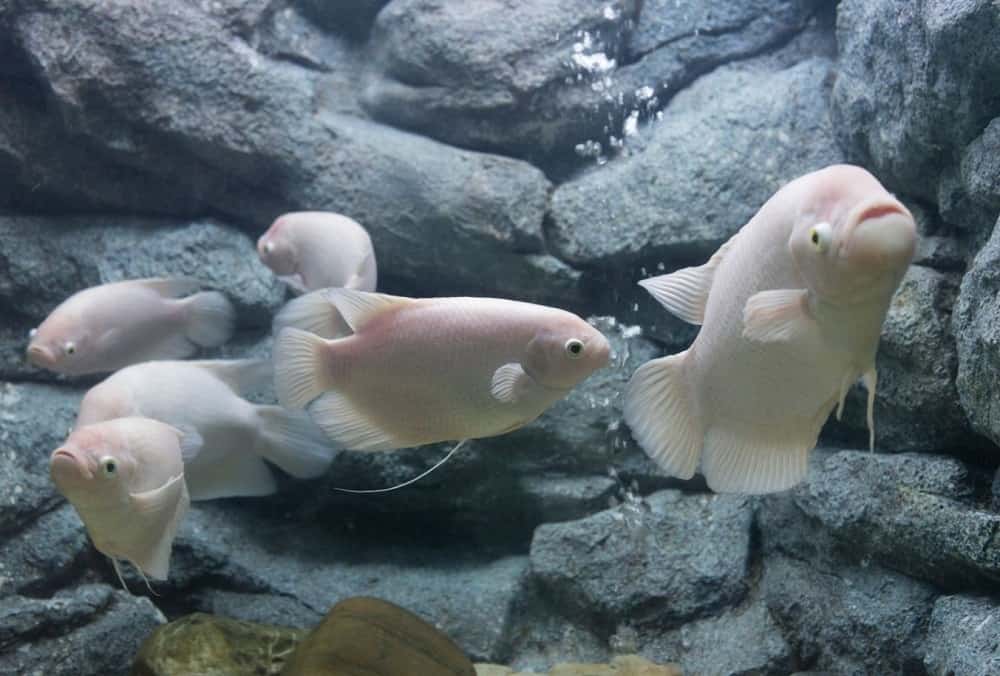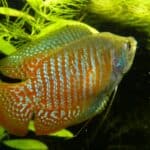The giant gourami (scientifically known as Osphronemus goramy) is the largest of the gourami species. Native to Southeast Asian freshwater habitats, the giant gourami remains true to its name with documented sizes of up to 26” long.
This species has a conservation status of Least Concern due to its wide distribution and benefits in the wild.

In its natural habitat, the giant gourami’s omnivorous diet is used for weed control purposes against invasive aquatic plants, which is why they aren’t often hunted by humans. This species is also known for its unique ability to survive out of water for a long period of time as they can breathe through moist air alone.
The giant gourami is only recommended to be kept in captivity by hobbyists who can accommodate their large size, and therefore their large tank size. Still, the giant gourami is a fairly easy fish to take care of – not to mention their unique behavior that indicates intelligence.
Care Guide
Tank Size
An adult giant gourami requires a tank with a capacity of 800 gallons at least. This is the main problem for hobbyists, because not everyone has the space to own a tank of this size. This is because of their fast growth rate (they can grow from 7.5-50 cm within four years) and the amount of space they require swimming around.
The general size guide for a giant gourami tank is one that is 2 meters long, 27.5 inches wide, and something nice and high.
If you decide to own a giant gourami from a juvenile age, you can keep around four juvenile 4” long fish in a 90-gallon tank. However, you need to be prepared to replace this tank once the fish begin to outgrow it.
Tank Mates
Interestingly, the juvenile giant gourami tends to be more aggressive than adult giant gourami. This is most likely due to the predators that threaten the juveniles in the wild. However, with time and suitable tank mates, the giant gourami is a good fish to have in any large tank among other fish.
The general rule of thumb when finding suitable tank mates is to make sure the tank mates aren’t small enough for the giant gourami to eat them (unless that’s your intention).
It’s best to opt for fish that are a similar size to the giant gourami (or slightly bigger), like catfishes, silver arowana, silver dollar, motoro, or large cichlids. The giant gourami will tolerate fish of a similar size as neither will be considered prey to each other.
Same Species Tanks
Giant gourami work best when in a group of 4-5 of the same species so they know they are the dominating species, but this means you will need a tank that can accommodate this many fish. Raising them from a young age in the same tank is the best way to ensure all the fish get along as adults.
Water Parameters
Just because the giant gourami can adapt to breathing in areas of low oxygen levels does not mean that you can avoid changing the water as usual. If anything, it’s imperative that you don’t get lazy with the water parameters to prevent causing health problems.
We recommend renewing 25% of the water each week, because the giant gourami is a notoriously messy eater who will leave a lot of organic waste.
Fortunately, the giant gourami can adapt to many water parameters, so other than renewing the water, there are only three things to keep on top of: the temperature, acidity, and water hardness. The temperature of the water should be 65-90 °F, the acidity levels should be at 6-8 pH, and the water hardness can be up to 30 dGH.
What To Put In Their Tank
The giant gourami doesn’t need an abundance of decorations in their tank. These fish need a lot of space to swim, which they can’t do if there are plants and rocks blocking the way. Any decorations, therefore, must be placed on the floor of the tank and the edges.
Rocks, large stones, and caves are great for giant gourami to explore and hide if they want to. Just ensure that the stones don’t have any sharp edges that could injure the fish. There’s almost little point in filling the tank with real aquatic plants, because the giant gourami will inevitably eat the plants. We recommend filling the blank spaces with fake aquatic plants that are hardy enough to not be eaten by the fish.
The bottom of the tank should be filled with a dark-colored substrate, while the surface of the water can be covered with fluctuant. We recommend finding a fast-growing species, as the giant gourami will feast on the greenery!
Common Diseases
The giant gourami isn’t exposed to any species-specific diseases, though here are some common diseases to look out for:
- Freshwater ich
- Flukes
- Fungal diseases
- Viral diseases
- Costia infection
- Nematodes infection
- Tail and fin rot
Prevention is the cure to most of these common diseases. Fortunately, captive environments like hobbyist’s tanks are far safer for the giant gourami against such diseases than in the wild.
Still, the best way to prevent your fish becoming sick is to renew 25% of the water each week, stick to the temperature/acidity/water hardness levels, and stay away from sharp rocks that could injure the fish and lead to infections.
As with any pet, if in doubt, go to the vets!
Food & Diet
Giant gourami are notorious for eating just about anything. In the wild, this species will eat aquatic plants, frogs, small fish, insects, and even carrion (dead flesh).
This means that owners need to replicate this diet as much as possible with a mixture of commercial fish food, protein (worms and other insects), and aquatic plants. Introducing a group of small fish is great for allowing their predator nature to thrive as they can hunt for their food.
Unlike some large fish, avoid feeding your giant gourami mammal flesh as they cannot digest this meat.
Make sure to feed the giant gourami once a day – no more, no less. These fish are very expectant of food, but overfeeding can lead to an early death.
Lifespan
With good care, the giant gourami can live up to 20 years, which is one of the reasons why this is such a popular species amongst hobbyists!
Appearance
The total length of a giant gourami, including the tail, can reach up to 26” long, making it the largest of the gourami species. As juveniles, the giant gourami has a pointed face with around 8 dark stripes on its body.
When it matures, the stripes disappear as their scales go even paler, and their heads turn into a rounder, more bulbous shape. They will also have a distinctive protruding jaw.
The abdominal fins, interestingly, have adapted a tactile organ in the form of a long, string-like fin. The dorsal and anal fins are around the same size as each other.
As for the color of the scales, the colors vary from golden-yellow to pale yellow, often with silver highlights or pale blue stripes. By the time they are adults, the giant gourami is almost completely white, and like humans, they will often turn gray towards the end of their lives. There are also artificially bred variations including black, albino, silver, and gold.
Size
The giant gourami is the largest of all gourami species, with an average size of 26” long including the tail. Their size is the reason why they need a correspondingly large tank.
Behavior & Temperament
As juveniles, giant gourami can be fairly aggressive. This is most likely due to trying to warn off larger predators who would prey on the young species. However, as they mature, the giant gourami becomes a laid-back and peaceful fish that just wants to swim around its tank.
Breeding
Giant gouramis are egg-laying fish that like to keep their eggs in nests made of aquatic plants, organic waste, and anything else they can find. In reality, the fish do their thing and everything works smoothly in the wild, but it’s a different story for breeding at home.
If juvenile giant gouramis require 90 gallons of water and adults require 800 gallons of water each, then think about how large a breeding tank would need to be.
Gender Differences: Male vs Female
Giant gouramis are mostly sexually dimorphic, with the females possessing rounded fins and lips while the males have a larger forehead, sharper dorsal fin, and darker coloring.
Fun Facts
- Gourami is a popular cuisine in its native Asian countries due to its size, making it a great source of protein. These fish also don’t have tiny bones, making them incredibly easy to eat.
- The natural habitats of the giant gourami include rivers, marshes, swamps, lakes, and streams across Southeast Asia.
- Giant gouramis are notorious for eating everything, which is why they are often used for weed control. They particularly like to eat giant salvinia – an invasive aquatic plant that completely covers lakes.








